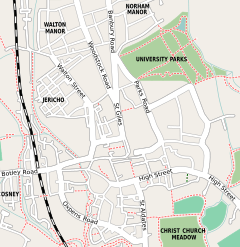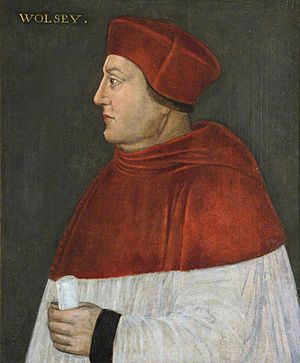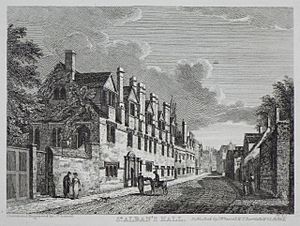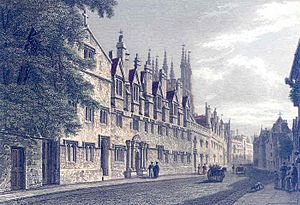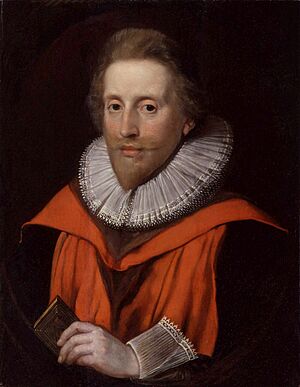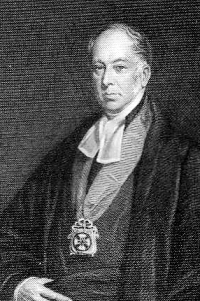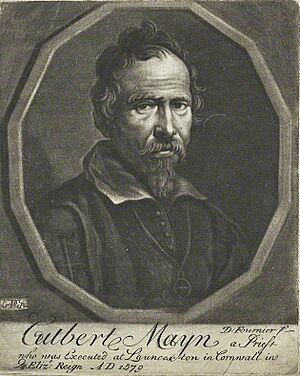St Alban Hall, Oxford facts for kids
Quick facts for kids St Alban Hall |
|
|---|---|
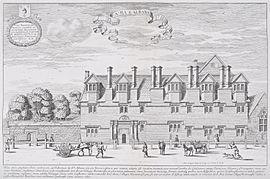
St Alban Hall in 1675, by David Loggan
|
|
| University | University of Oxford |
| Location | Merton Street |
| Coordinates | 51°45′04″N 1°15′05″W / 51.7512°N 1.2513°W |
| Latin name | Aula Sancti Albani |
| Established | c. 1230 |
| Closed | 1882 (incorporated into Merton College) |
| Named for | Robert of Saint Alban |
| Principal | See below |
| Map | |
St Alban Hall, sometimes called St Alban's Hall, was a very old part of the University of Oxford. It was one of the "medieval halls," which were like smaller colleges. It started around the 1200s and was one of the longest-lasting. Even though it was bought by a nearby college, Merton College, in the 1500s, it kept running on its own for a long time. Eventually, in the late 1800s, it officially joined Merton College. Today, the place where St Alban Hall used to be is now part of Merton College's St Alban's Quad.
Contents
History of St Alban Hall
How St Alban Hall Began
St Alban Hall got its name from Robert of Saint Alban. He was a citizen of Oxford who gave the property to a group of nuns at Littlemore around the year 1230.
In 1525, a powerful leader named Thomas Wolsey, who was the King's chief advisor, closed the nuns' priory (their home). This happened because of some problems at the priory. All the land and houses in Oxford that belonged to the priory, including St Alban Hall, then went to Wolsey. He planned to use them for his new college, called Cardinal College.
Changes in Ownership
When Thomas Wolsey lost his power in 1529, his wealth and lands, including Littlemore Priory, went back to the King. King Henry VIII then gave St Alban Hall to George Owen. He was the King's doctor and also a member of Merton College.
George Owen later sold the Hall to Sir John Williams and Sir John Gresham. With permission from King Edward VI, they transferred the Hall to John Pollard and Robert Perrot in 1547. These two then sold it to the leaders and members of Merton College.
Running as a Separate Hall
Even though Merton College now owned St Alban Hall, it continued to operate separately for another 300 years. It had its own students and its own leader, called a principal. The university's rules for academic halls guided how it was run. The principal was chosen by the university's chancellor.
In 1825, the university's chancellor, Grenville, appointed Richard Whately as principal. He hoped to improve the standards at the Hall. Famous figures like John Henry Newman and Samuel Hinds worked as vice-principals there for a few years.
Life at St Alban Hall
In the mid-1830s, there was a time when St Alban Hall had only one student, John Robert Tennant. He was known as "the solitary tenant of Alban Hall." By 1838, there were seven students, and later, twelve. The only teacher was the vice-principal. Students who wanted to earn an honors degree often hired private tutors.
The Hall had four staff members: a cook, a person who managed food supplies, a porter (like a doorman), and a young helper. One former student, Dr Henry Robinson, remembered that St Alban Hall was "rather an expensive place." This was because there were so few students and no special funds to help with costs.
The End of St Alban Hall
The last principal, William Charles Salter, was in charge from 1861 until he left in 1882. In 1877, the Prime Minister, Disraeli, set up a group of people to look at how the university and its colleges could be improved. This group decided that the four remaining medieval halls, including St Alban Hall, were not working well enough and should join with larger colleges.
In 1881, a new university rule was made. It stated that St Alban Hall would join Merton College when Principal Salter left or passed away. When he resigned, the eighteen students living at the Hall were then accepted into Merton College. St Alban Hall officially became part of Merton College in 1882. Only St Edmund Hall managed to avoid being merged with another college.
Dr Henry Robinson, who had studied at St Alban Hall, felt sad about its closure. He believed it was destroyed because "it has no friends." He thought no one cared about it except the principal, who was given a retirement payment. Robinson felt its closure was not necessary, but there was no one to defend it.
Buildings of St Alban Hall
The buildings of St Alban Hall included a main courtyard and a smaller one. The part of the building facing Merton Street was rebuilt in 1600. Later, from 1863, the buildings were rebuilt again, and a chapel was added. This work was paid for by Principal Salter.
After St Alban Hall joined Merton College in 1882, the chapel was no longer needed for religious services. Between 1904 and 1910, most of the old Hall buildings were taken down. Only a small part of the front wall on Merton Street remained. On this site, Merton College built its new St Alban's Quadrangle.
Principals
Here is a list of the leaders, or principals, of St Alban Hall:
- 1437: Roger Martin
- 1439: Robert Ashe
- 1444: John Gygur
- 1450: William Shyrefe
- 1452: William Romsey
- 1468–1477: Thomas Danett
- 1477: Richard FitzJames, later Bishop of London
- Thomas Lynley
- Robert Gosbourne
- Ralph Hamsterley
- 1501: Hugh Saunders, alias Shakspeere
- 1503: John Forster
- 1507: John Beverstone
- 1507: William Bysse
- 1509: Richard Walker
- 1510: John Pokyswell
- 1514: John Hoper
- Simon Balle
- 1527: Walter Buckler
- 1530: Robert Tailer
- 1532: William Pedyll
- 1535: Robert Huyck
- 1536: Richard Smyth, also first Regius Professor of Divinity at Oxford
- 1539: Humphrey Burneford
- 1543: John Estwyck
- 1547: William Marshall
- 1567: Arthur Atye
- Richard Radclyffe
- 1599: Robert Masters
- 1603: Henry Masters
- 1614: Anthony Morgan
- 1621: Richard Parker
- 1624: Edward Chaloner
- 1625–1661: Richard Zouch
- 1641: Sir Giles Sweit
- 1664–1673: Thomas Lamplugh
- 1673–1679: Narcissus Marsh
- 1679: Thomas Bouchier
- 1692: Richard Duckworth
- 1723: James Bouchier
- 1736: Robert Leyborne
- 1759: Francis Randolph
- 1797–1823: Thomas Winstanley
- 1823–1825: Peter Elmsley
- 1825–1831: Richard Whately, later Archbishop of Dublin
- 1831–1861: Edward Cardwell
- 1861–1882: William Charles Salter
Notable Alumni
Many interesting people studied at St Alban Hall over the years. Here are some of them:
- Cuthbert Mayne (c. 1543–1577), a Roman Catholic priest
- Sir Thomas Gresham (died 1630), a landowner and member of parliament
- Robert Harcourt (died 1631), an explorer
- Thomas Crompton (died 1608), a lawyer and judge
- Thomas Lawton (c. 1558–1606), a lawyer and judge
- John Penry (1563–1593), a Welsh Protestant leader
- Matthew Slade (1569–1628), a nonconformist minister
- Gervase Clifton, 1st Baron Clifton (c. 1570–1618), a landowner and noble
- Edward Lapworth (1574–1636), a doctor and Latin poet
- Philip Massinger (1583–1640), a famous writer of plays
- William Lenthall (1591–1662), who was the Speaker of the House of Commons
- Samuel Turner (c. 1582–1647), a soldier who fought for the King
- Sir Richard Browne, 1st Baronet, of Deptford (died 1683), an English ambassador to France
- Richard Alleine (1610/11–1681), a Puritan religious leader
- William Alleine (1614–1677), a clergyman
- Bartholomew Ashwood (1622–1680), a Puritan religious leader
- John Durel (1625–1683), a clergyman
- Thomas Hancorne (1642–1731), a clergyman
- Francis Willis (1718–1807), a doctor
- John Evans (1756–1846), a Welsh surgeon and mapmaker
- Stephen Reay (1782–1861), a professor of Arabic
- Nathaniel Dawes (1843–1910), an Anglican bishop in Australia
- Edward Smith (1854–1908), a clergyman and first-class cricketer


